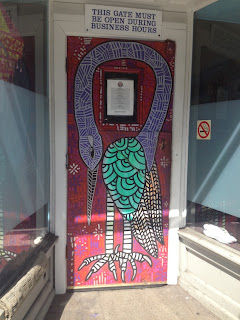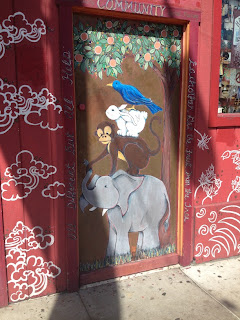This weeks outing was to the Haight-Ashbury district, widely known as being the home of the counterculture movement. It was a beautifully sunny and warm day, and this made for a great walking tour of the neighborhood.
A Step Back in Time
Do you remember
your first time visiting the Haight-Ashbury district of San Francisco? I do. I
was 16, and although I had known a bit of the history of the neighborhood, I
had no idea why the area was still such a popular tourist destination. Coming
from Los Angeles, The Haight just seemed like another Melrose to me; another
destination to shop and take in the cool atmosphere cultivated by those who
live and work in the area. It wasn’t until I really began to explore and learn
about the history that I realized how important of a location Haight-Ashbury is
to modern culture today. Visiting Haight-Ashbury is like taking a step back
into a very revolutionary time, a time where free expression and mind expansion
reigned above all else. This sense of counterculture, wherein the culture
itself rejects modern culture, is still very alive today, and by visiting
Haight-Ashbury you can either re-live or experience for the first time what it
is like to be in such a revolutionary period.
What exactly is
counterculture, and why does it still bring so many people to the
Haight-Ashbury district? Although counterculture ideas have sprung up numerous
times since the 18th century, the most recent and widely noted occurrence
of counterculture took place during the 1960’s.
Many civil rights and anti-war movements began what is known as the
Hippie Counterculture Movement, wherein many young citizens began to reject the
ideas of previous generations, and began to express themselves in a free
spirited manner. It was this phenomenon that changed American culture forever.
Haight-Ashbury is seen as the hearth for this counterculture movement, and
although much time has passed since this cultural boom, the district is as full
of revolutionary life as ever.
So why do people
still flock to this district if it’s been half a century since this explosion
of ideas and culture? Going to the Haight-Ashbury district gives you a chance
to open a time capsule filled with 1960’s memorabilia, and this in itself is a
major reason many tourists and even locals spend their time in The Haight. Going to this district gives people a chance
to re-live parts of their life, or in many cases, live this experience for the
first time. In a way its beautiful to have a place where this can happen; where
just by setting foot onto the streets of this particular area, you can join a
revolutionary time still revered as being a life changing time period for us
all.
On my most recent journey
to Haight-Ashbury, I began to take note of all of the signage around the area.
I began to realize how the signs of this district are tailored to fit a genre
of style and are quite unique in this sense. The signs I observed were very
psychedelic, reminiscent of the 1960’s counterculture movement. I noticed many
signs that represented other time periods, but in a way they were very tied
into the whole 1960’s counterculture era. Each sign portrayed vivid spectrums
of colors, and very artistic flowing fonts. This, combined with the dayglo colored
posters, made for a very “summer of love” type atmosphere.
Each sign gave a
sense of what happened as time carried on through The Haight. From the digital
signs of modern day apparel stores, to the neon glow of the 1980’s style burger
stand, each sign represents a different period in time; each sign gives a piece
of information as to what The Haight has been through over the past 50 years. Each
sign adds to the sense of place and gives The Haight its world-renowned style.
I feel so much
more enriched and understanding of why Haight-Ashbury is such a tourist
destination. It is now, now that ive analyzed what it is that makes The Haight
what it is today, that I realize how much this one district has been through.
It is now that I realize how cultured this one neighborhood of San Francisco
is, and it is now that I realize how much of a community this neighborhood
really is. It really is amazing how much you learn by just stopping to observe
your surroundings. While I have experienced the Haight-Ashbury district before,
it is now that I feel as if I really know
the district.


















































